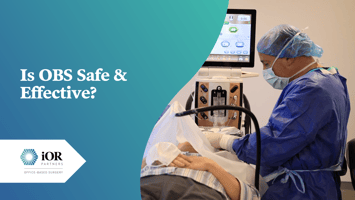When it comes to office-based surgery (OBS), the first question on every ophthalmologist’s mind is,...
Rethinking Cataract Surgery with Innovation and Policy Shifts
Cataract surgery is one of the most common procedures in the United States, with over four million operations performed annually . From the intricate, inpatient procedures of the past to today’s modern outpatient approaches, innovation has made cataract surgery safer, faster, and more accessible.
Looking ahead, innovation alone won’t drive progress. Smart policy updates are essential to improving both patient outcomes and cost efficiency. The Journal of the American Medical Association published the article “A New Vision for Site-Neutral Policy.” that explores how shifts in payment structures, combined with clinical innovation, could reduce costs, enhance accessibility, and streamline cataract care—with the ultimate goal of improving patient outcomes.

Site-Neutral Payments and Their Potential
The concept of site-neutral payment could be a game-changer in cataract surgery and in healthcare overall. It aims to reimburse providers the same amount for a procedure, regardless of where it is performed. For cataract surgery, adopting this model could save the healthcare system $471 billion over the next decade2.
Currently, structural differences in Medicare prevent these benefits from being fully realized. ASCs offer a more cost-effective solution compared to hospital outpatient departments (HOPDs), yet some procedures could transition further to a lower-cost setting, such as an office-based surgical suite.
For cataract surgery, policymakers could support the shift to office-based procedures by increasing professional fees under Medicare's physician fee schedule. This adjustment would incentivize ophthalmologists to perform cataract surgeries in-office without compromising safety or quality.
Supporting Innovation Through Policy
To fully realize these opportunities, policymakers must support evidence-based clinical research and adjust payment systems to reward innovation. Instead of penalizing cost-saving advancements with reduced reimbursements, policies should encourage the adoption of effective, lower-cost procedures.
For example, small-incision phacoemulsification transformed cataract surgery into a quick, outpatient procedure in the 1980s, yet, 90% of Medicare beneficiaries still receive IV sedation with an anesthesia provider. A growing amount of research shows that mild sedation is appropriate for cataract patients while eliminating costs for medical clearance and an anesthesia provider.
Expanding site-neutral principles and eliminating prior authorization requirements for anesthesia care will allow for a seamless transition across settings, from HOPDs to ASCs and ultimately to office-based models. This will empower ophthalmologists to make patient-centered decisions without financial disincentives.
Excerpt from JAMA article, “A New Vision for Site-Neutral Policy
If sufficient evidence in the form of domestic, prospective, methodologically rigorous studies continues to demonstrate that, with appropriate patient selection, cataract surgery outcomes are unchanged when performed without a dedicated anesthesiologist or nurse anesthetist, with time, this health care delivery model could become a new standard of care. This transition also might help optimize anesthesia resource allocation and alleviate current anesthesia staffing challenges. Recognizing these potential long-term positive gains, policymakers should support additional clinical research in evaluating the safety of office-based cataract surgery while positioning payment policy to reward rather than penalize physicians for clinical innovation that reduces costs.

Why the Future of Cataract Surgery Lies in Office-Based Models
Office-based surgical models hold tremendous promise for cataract surgery. Moving surgery to office setting significantly reduces costs while maintaining the highest level of patient safety.
For surgeons, OBS empowers greater control over the surgical environment, anesthesia, and premium lens offerings, which can significantly boost practice revenue. Combined with robust sterility regulations and proper oversight, OBS is carving a path toward more efficient and scalable cataract care.
There is no need to wait for policy changes to implement office-based surgery. Until OBS reimbursement is standardized, iOR Partners has a well-established, compliant billing model working with local payers to collect reimbursement on ophthalmic office-based procedures. We have successfully collected reimbursements from all major payors nationwide, including Medicare, with zero refunds or deficiencies.
Find out what secondary-local reimbursements are in your area with a free analysis.




